LEDProjects 3x1W ledspot GU10 dimmable
Posted by Marcel van der Steen in Led lights, Light measurements 3 Comments» presents a lightbulb like a spotlight, with GU10 fittings, 3 high power leds, a warm white light and dimmable as well. This article shows diverse lamp parameters, also gathered together in an Eulumdat file.
presents a lightbulb like a spotlight, with GU10 fittings, 3 high power leds, a warm white light and dimmable as well. This article shows diverse lamp parameters, also gathered together in an Eulumdat file.
See this overview for a comparison with other light bulbs.
Summary measurement data
| parameter | meas. result | remark |
|---|---|---|
| Color temperature | 2929 K | Warm white |
| Luminous intensity Iv | 515 Cd | |
| Beam angle | 25 deg | |
| Power P | 4.1 W | |
| Power Factor | 0.76 | For every 1 kWh net power consumed, there has been 0.9 kVAhr for reactive power. |
| Luminous flux | 128 lm | |
| Luminous efficacy | 31 lm/W | |
| CRI_Ra | 84 | Color Rendering Index. |
| Coordinates chromaticity diagram | x=0.4389 and y=0.3998 | |
| Fitting | GU10 | |
| D x L external dimensions | 50 x 59 mm | External dimensions of the light bulb. |
| D luminous area | 38 mm | Dimensions of the luminous area (used in Eulumdat file). This is equal to the size of an imaginary circle around the three leds in the front face of the light bulb. |
| General remarks | The ambient temperature during the whole set of measurements was 22.5-27 deg C.Warm up effect: during the warm up time the illuminance decreases with 16 % as well does the consumed power.
Voltage dependency: the illuminance and power consumption are dependent on the voltage. Their dependence is linear. The light bulb can be dimmed, and the effect of dimming on interesting parameters is tested. The result is dependent on the type of dimmer used. |
|
| Measurement report (PDF) | tdb | |
| Eulumdat file |  |
Right click on icon and save the file. |
Eulumdat light diagram
An interesting graph is the light diagram, indicating the intensity in the C0-C180 and the C90-C270 plane. This light diagram below comes from the program Qlumedit, that extracts these diagrams from an Eulumdat file.
The light diagram giving the radiation pattern.
It indicates the luminous intensity around the light bulb. The C0-C180 plane and the C90-C270 give the same diagram, as the light bulb is symmetrical along the z-axis.
The diagram shows a focused light beam.
The unit is Cd/1000lm, meaning the intensity in Cd assuming there would be 1000 lumen in the measured light bulb. This enables comparing different types of light bulbs.
Illuminance Ev at 1 m distance, or luminous intensity Iv
Herewith the plot of the averaged luminous intensity Iv as a function of the inclination angle with the light bulb.
The radiation pattern of the light bulb.
This radiation pattern is the same as the one given earlier, as there is no difference in results between C-planes, due to the symmetry in the z-axis of this light bulb. However in this graph the luminous intensity is given in Cd.
These averaged values are used (later) to compute the lumen output.
Intensity data of every measured turn angle at each inclination angle.
This plot shows per inclination angle the intensity measurement results for each turn angle at that inclination angle. There are differences in illuminance values for different turn angles. However for further calculations the averaged values will be used.
When using the average values per inclination angle, the beam angle can be computed, being 25 degrees.
Luminous flux
With the averaged illuminance data at 1 m distance, taken from the graph showing the averaged radiation pattern, it is possible to compute the luminous flux.
The result of this computation for this light spot is a luminous flux of 128 lm.
Luminous efficacy
The luminous flux being 128 lm, and the power of the lightbulb being 4.1 W, yields a luminous efficacy of 31 lm/W.
A power factor of (almost) 0.76 means that for every 1 kWh net power consumed, a reactive component of 0.9 kVAr was needed.
| Light bulb voltage | 230 V |
| Light bulb current | 24 mA |
| Power P | 4.1 W |
| Apparent power S | 5.4 VA |
| Power factor | 0.76 |
Of this light bulb the voltage across ad the resulting current through it are measured and graphed.
Voltage across and current through the lightbulb
The current is in phase with the voltage. Its form is not sinusiodal, but is a triangle wave with some dead/inactive timeperiods between the peaks of the voltage sinus. This is the reason why the power factor is less than one.
Also the power spectrum of the current is determined.
The powerspectrum of the current through the light bulb.
There are higher harmonics that are apparent in the spectrum.
Color temperature and Spectral power distribution
The spectral power distribution of this light bulb.
The measured color temperature is about 2950 K which is warm white.
This color temperature is measured straight underneath the light bulb. Below a graph showing the color temperature for different inclination angles.
Color temperature as a function of inclination angle.
The color temperature is given for inclination angles up to 70 degrees since at larger inclination angles there is too little illumination.
The value remains constant within 8 %.
Chromaticity diagram
The chromaticity space and the position of the lamp’s color coordinates in it.
The light coming from this lamp is close to the Planckian Locus (the black path in the graph).
Its coordinates are x=0.4389 and y=0.3998.
Color Rendering Index (CRI) or also Ra
Herewith the image showing the CRI as well as how well different colors are represented (rendered). The higher the number, the better the resemblance with the color when a black body radiator would have been used (the sun, or an incandescent lamp).
Each color has an index Rx, and the first 8 indexes (R1 .. R8) are averaged to compute the Ra which is equivalent to the CRI.
CRI of the light of this lightbulb.
The value of 84 is higher than 80 which is considered a minimum value for indoor usage.
Note: the chromaticity difference is 0.0020 indicates the distance to the Planckian Locus. Its value is lower than 0.0054, which means that the calculated CRI result is meaningful.
Voltage dependency
The dependency of a number of lamp parameters on the lamp voltage is determined. For this, the lamp voltage has been varied and its effect on the following lamp parameters measured: illuminance E_v [lx], color temperature CT or correlated color temperature CCT [K], the lamppower P [W] and the luminous efficacy [lm/W].
Lamp voltage dependencies of certain light bulb parameters, where the value at 230 V is taken as 100 %.
The consumed power and the illuminance vary significantly when the voltage varies between 200-250 V.
When the voltage at 230 V varies with + and – 5 V, then the illuminance varies with less than + and – 5 %, when abrupt voltage changes occur (in order of 5 V) this effect is most likely not visible in the illuminance output.
Warm up effects
After switch on of a cold lamp, the effect of heating up of the lamp is measured on illuminance E_v [lx], color temperature CT or correlated color temperature CCT [K], the lamppower P [W] and the luminous efficacy [lm/W].
Effect of warming up on different light bulb parameters. At top the 100 % level is put at begin, and at bottom at the end.
The warming up takes about 20 minutes. During this time, the illuminance has decreased with 16% and the consumed power has decreased with 16 %.
Dim-ability
The effect of a number of dimmers on interesting lamp parameters is tested. In every graph the x-axis represent the amount of dimming. It can be compared with the mechanical position of a knob used to set the amount of dimming: 0 % is maximum dimming, and 100 % is no dimming.
Dimresult with the Elro dimmer
 The used Elro dimmer (zie spec) fits in an outlet in the wall, and then the lamp needs to be fed from the outlet in this dimmer. A mechanical knob is used to set the level op dimming.
The used Elro dimmer (zie spec) fits in an outlet in the wall, and then the lamp needs to be fed from the outlet in this dimmer. A mechanical knob is used to set the level op dimming.
Dimresult with the Elro dimmer
The dimming function works, down to 0 % light output using a mechanical range of 40 – 90 %. The consumed power decreases slower than the light output does, resulting in a decrease of the efficiency.
Note: this dimmer requests minimum loads of 20 VA, which is more than this single led consumes. It is therefore unknown how this light bulb will dim on other dimmers unless a dimmer is used that is specified for low power loads.
Dimresult with the Gira dimmer
 The Gira dimmer can be build in in a power box inside walls (spec) and is used to dim incandescent light bulbs and halogen light bulbs. Using a know the dim function has 36 different positions (35 steps).
The Gira dimmer can be build in in a power box inside walls (spec) and is used to dim incandescent light bulbs and halogen light bulbs. Using a know the dim function has 36 different positions (35 steps).
Dimresult with the Gira build in dimmer, going from no dimming to max dimming
The dimming function works for the 45 – 90 % of the mechanical position range of the knob. In this areas the light output is settable between 100 and 5 %. Further turning the knob to more dimming, results in a higher light output!
This strange behavior is due to the fact that the light bulb is too little a load for this dimmer.
There is a slightly different result when the knob is turned from maximal dimming towards minimal dimming.
The 0 % illumination level is given for more mechanical positions, until at 52 % where the dim function behaves the same as before (when the knob was turned to more dimming).
It might be that putting more of these lightbulb in parallel and connecting these to one dimmer, such that the minimum load is satisfied, will work.
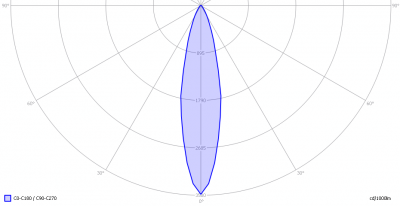
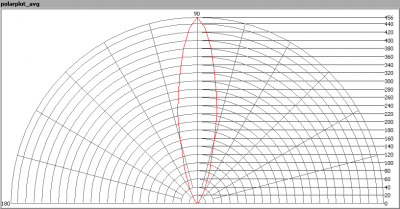
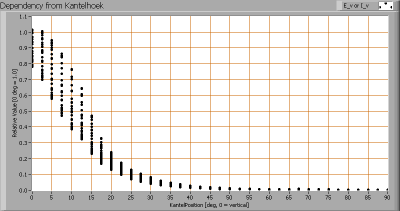
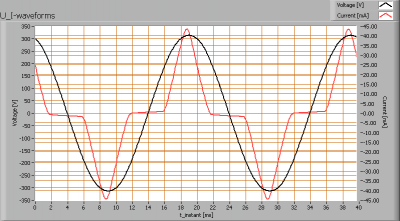
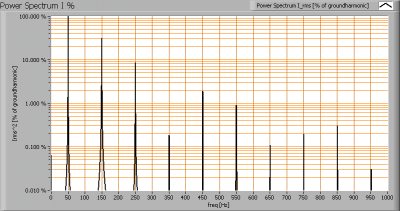
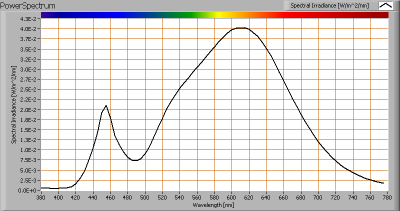
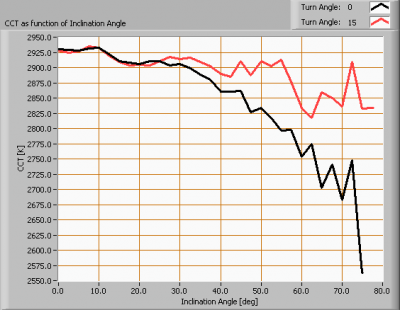
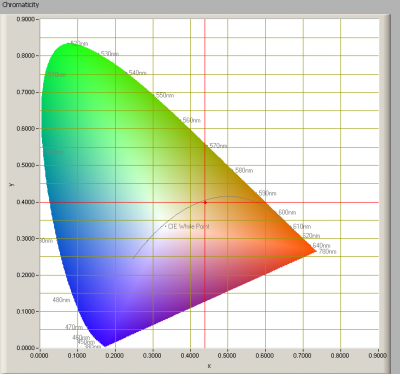
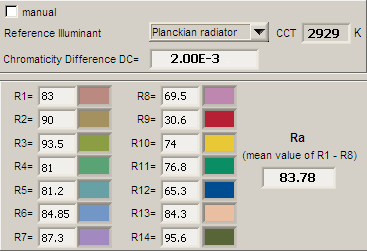
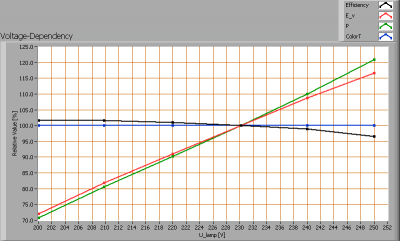
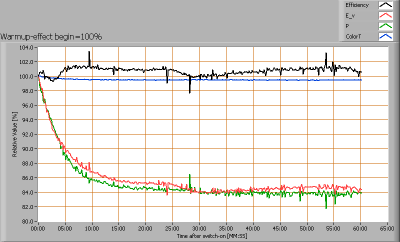
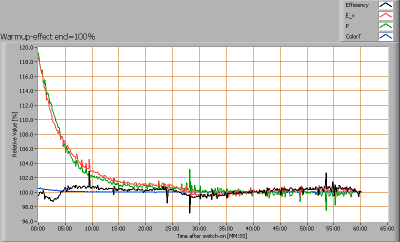
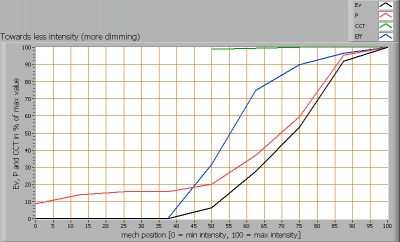
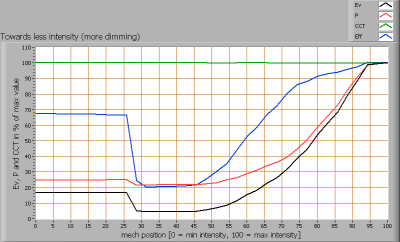
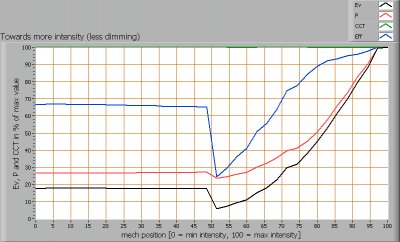





3 replies on “LEDProjects 3x1W ledspot GU10 dimmable”
Are these bulbs available in America for 120V electricity?
http://www.olino.org/articles/2009/12/30/leditlight-gu10-led-spot-warm-wit-4w
We can do this (non-dimmable) spot in 110v
And also this new 224 lumen dimmaable spot:
http://www.olino.org/articles/2009/12/28/leditlight-3x3w-cree-gu10-warm-wit-dimbaa
Hi
for a indoor design project, I need some 50 – 100 power LED GU10 warm white, dimmable. My hometown is Luenenburg, Germany. Where can I buy, can you ship directly and what would be your best bulk price?
Best geragds,
Nick